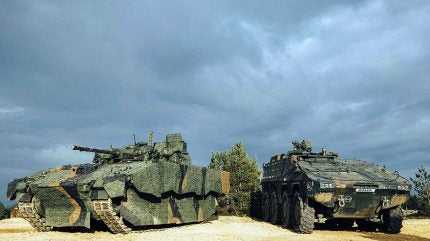
If either one of the British Army’s armoured vehicle programmes slip this year, its capability gap will continue to run well beyond the early 2030s.
In a parliamentary written response on 21 November, a senior MoD official laid out the planned operational structure. The Army will deploy four Heavy Mechanised Infantry Battalions across two Armoured Brigades.
These battalions will be equipped and structured around the Boxer platform, with the first battalion due to reach Initial Operating Capability at the end of 2025. Likewise, the long-awaited Ajax vehicle faces a similar time frame.
In the interim, the Army is left to operate the tracked Warrior Infantry Fighting Vehicle, which the Army has said the Boxer is not a direct replacement, and is a legacy platform approaching 40 years of service, according to GlobalData’s United Kingdom Defence Market report.
Nevertheless, last month, the MoD indicated that Warrior will remain effective until new capabilities are introduced.
Not only is the Warrior not designed to fit neatly into a new digitally connected network of land assets (Ajax, Boxer, Challenger, Apache), the UK Government says that its out of service date was in 2023, and that this was extended from 2014.
How well do you really know your competitors?
Access the most comprehensive Company Profiles on the market, powered by GlobalData. Save hours of research. Gain competitive edge.

Thank you!
Your download email will arrive shortly
Not ready to buy yet? Download a free sample
We are confident about the unique quality of our Company Profiles. However, we want you to make the most beneficial decision for your business, so we offer a free sample that you can download by submitting the below form
By GlobalData
Modernisation leaves more to be desired
Ahead of the Strategic Defence Review, which is meant to set out priority guidelines in the spring of 2025, the UK Government has acted without a discernible plan of action.
Last week, the Secretary of State for Defence, John Healey, announced a new round of cuts for certain close-to-obsolete defence programmes. It has left the British Army without a tactical drone capability and the Royal Navy with fewer surface ships as part of a cost-saving measure for the department.
Clearly, the British budget, since the end of October, does not allow the government to make any promises when it comes to cuts to legacy programmes such as the Warrior.
“Getting Boxer and Ajax to the IOC stage is an important step to modernising the capabilites, interoperability and deterrence of the British Army. But these are drops in a very large bucket when we consider the rate of expenditure and the massive quantitative scale required to dominate on a high-intensity battlefield,” observed GlobalData defence analyst Tristan Sauer.
“The UK has nowhere near enough equipment, personnel and budget to make its force effective against a real threat (i.e. Russia).” This is particularly concerning given that some defence observers expect Britain to fight the Russians by 2028 at the earliest.
“If Ajax does face delays, I can foresee Boxer being used to try and fill any capability gaps (wouldn’t be optimal, but make the best of a bad situation) because RBSL’s production is seen as reliable,” Sauer added.



